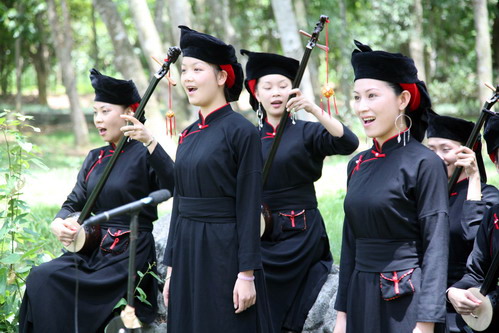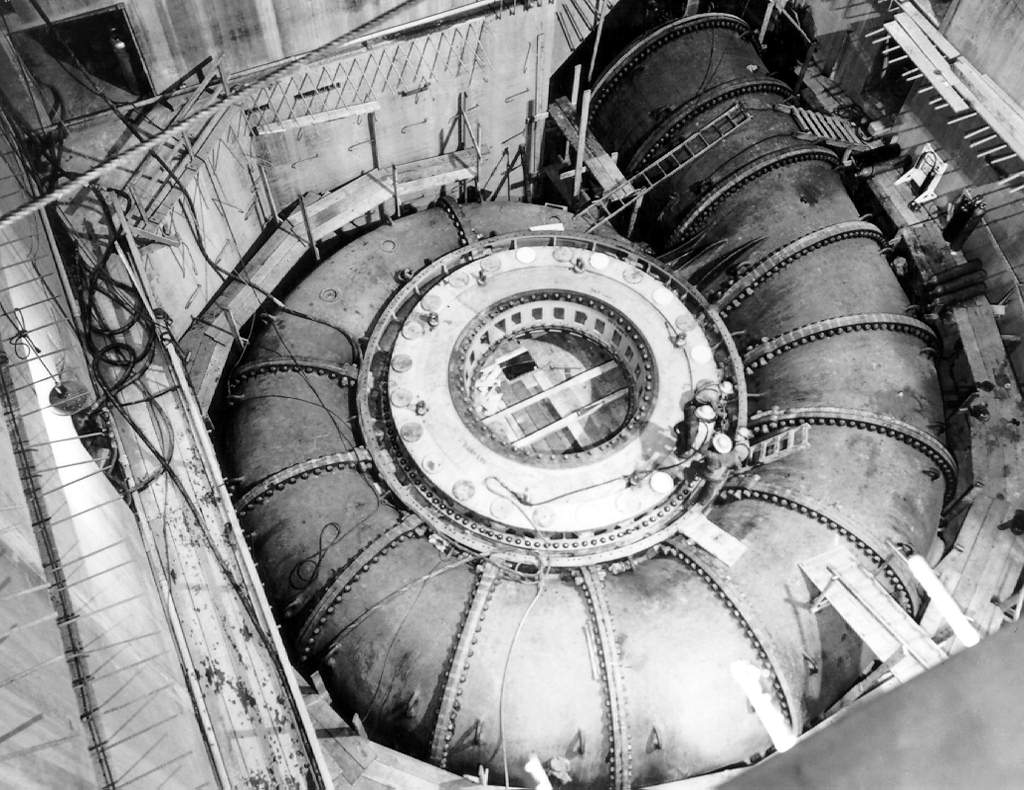|
Yantan Dam
The Yantan Dam () is a gravity dam on the Hongshui River near Dahua County, Guangxi China. The main purpose of the dam is hydroelectric power production and it has an associated 1,210 MW power station consisting of 4 x 302.5 MW Francis turbine-generators. Construction The dam was placed on the state key project list in 1984 and construction began in March 1985. By November 1987, the river was diverted and in March 1992, the dam began to impound the reservoir. On September 16, 1992, the first generator was operational nine months ahead of schedule. The second generator was operation in August 1993, the third in June 1994 and the fourth in June 1995. By the end of 1995, the entire project was complete. The dam is owned by Guangxi Electric Power Bureau while Guangxi Electricpower Investigation and Design Institute designed it and Guangxi Yantan Hydropower Project Construction Corporation constructed it. 43,176 people were relocated as a result of the project. Design The facilit ... [...More Info...] [...Related Items...] OR: [Wikipedia] [Google] [Baidu] |
China
China, officially the People's Republic of China (PRC), is a country in East Asia. It is the world's List of countries and dependencies by population, most populous country, with a Population of China, population exceeding 1.4 billion, slightly ahead of India. China spans the equivalent of five time zones and Borders of China, borders fourteen countries by land, the List of countries and territories by land borders, most of any country in the world, tied with Russia. Covering an area of approximately , it is the world's third List of countries and dependencies by area, largest country by total land area. The country consists of 22 provinces of China, provinces, five autonomous regions of China, autonomous regions, four direct-administered municipalities of China, municipalities, and two special administrative regions of China, Special Administrative Regions (Hong Kong and Macau). The national capital is Beijing, and the List of cities in China by population, most populous cit ... [...More Info...] [...Related Items...] OR: [Wikipedia] [Google] [Baidu] |
Dahua Yao Autonomous County
Dahua Yao Autonomous County ( zhuang: ; ) is a county of west-central Guangxi, China. It is under the administration of Hechi Hechi () is a prefecture-level city in the northwest of the Guangxi Zhuang Autonomous Region, People's Republic of China, bordering Guizhou to the north. In June 2002 it gained city status. Geography and climate Hechi is located in northwester ... city. It was established in 1987 on 23 December. References County-level divisions of Guangxi Administrative divisions of Hechi Yao autonomous counties {{Guangxi-geo-stub ... [...More Info...] [...Related Items...] OR: [Wikipedia] [Google] [Baidu] |
Guangxi
Guangxi (; ; alternately romanized as Kwanghsi; ; za, Gvangjsih, italics=yes), officially the Guangxi Zhuang Autonomous Region (GZAR), is an autonomous region of the People's Republic of China, located in South China and bordering Vietnam ( Hà Giang, Cao Bằng, Lạng Sơn, and Quảng Ninh Provinces) and the Gulf of Tonkin. Formerly a province, Guangxi became an autonomous region in 1958. Its current capital is Nanning. Guangxi's location, in mountainous terrain in the far south of China, has placed it on the frontier of Chinese civilization throughout much of Chinese history. The current name "Guang" means "expanse" and has been associated with the region since the creation of Guang Prefecture in 226 AD. It was given provincial level status during the Yuan dynasty, but even into the 20th century, it was considered an open, wild territory. The abbreviation of the region is "" (Hanyu pinyin: ; Zhuang: ), which comes from the name of the city of Guilin, the provin ... [...More Info...] [...Related Items...] OR: [Wikipedia] [Google] [Baidu] |
Hongshui River
The Hongshui River is a major river in the Guangxi Zhuang Autonomous Region in Southern China. It is one of the main rivers in the basin of the Xi River, which in its turn is one of the main tributaries of the Pearl River. Because it flows through the red rock series area, the river is reddish brown, hence the name ''Hongshui River'' (). Conventionally, the Hongshui River is formed by the merging of the Beipan and Nanpan Rivers (Beipanjiang and Nanpanjiang, i.e., the Northern and Southern Pan Rivers) at the Guizhou-Guangxi border. From there, it flows in the general southeastern direction. In Laibin Prefecture in central Guangxi the Hongshui merges with the Liu River that comes from the north, forming the Qian River, which continues to the east toward, eventually, the Xi River. The Hongshui has 10 large dams on it, that provide electric power and flood control. According to the ''Beijing Review ''Beijing Review'' (), previously ''Peking Review'', is China's only natio ... [...More Info...] [...Related Items...] OR: [Wikipedia] [Google] [Baidu] |
Francis Turbine
The Francis turbine is a type of water turbine. It is an inward-flow reaction turbine that combines Radial turbine, radial and Axial flow turbine, axial flow concepts. Francis turbines are the most common water turbine in use today, and can achieve over 95% efficiency. The process of arriving at the modern Francis runner design took from 1848 to approximately 1920. It became known as the Francis turbine around 1920, being named after British-American engineer James B. Francis who in 1848 created a new turbine design. Francis turbines are primarily used for producing electricity. The power output of the electric generators generally ranges from just a few kilowatts up to 1000 MW, though mini-hydro installations may be lower. The best performance is seen when the Hydraulic head, head height is between . Penstock diameters are between . The speeds of different turbine units range from 70 to 1000 rpm. A Wicket gate (hydraulics), wicket gate around the outside of the Water tur ... [...More Info...] [...Related Items...] OR: [Wikipedia] [Google] [Baidu] |
Megawatt
The watt (symbol: W) is the unit of power or radiant flux in the International System of Units (SI), equal to 1 joule per second or 1 kg⋅m2⋅s−3. It is used to quantify the rate of energy transfer. The watt is named after James Watt (1736–1819), an 18th-century Scottish inventor, mechanical engineer, and chemist who improved the Newcomen engine with his own steam engine in 1776. Watt's invention was fundamental for the Industrial Revolution. Overview When an object's velocity is held constant at one metre per second against a constant opposing force of one newton, the rate at which work is done is one watt. : \mathrm In terms of electromagnetism, one watt is the rate at which electrical work is performed when a current of one ampere (A) flows across an electrical potential difference of one volt (V), meaning the watt is equivalent to the volt-ampere (the latter unit, however, is used for a different quantity from the real power of an electrical ci ... [...More Info...] [...Related Items...] OR: [Wikipedia] [Google] [Baidu] |
Hydroelectric
Hydroelectricity, or hydroelectric power, is electricity generated from hydropower (water power). Hydropower supplies one sixth of the world's electricity, almost 4500 TWh in 2020, which is more than all other renewable sources combined and also more than nuclear power. Hydropower can provide large amounts of low-carbon electricity on demand, making it a key element for creating secure and clean electricity supply systems. A hydroelectric power station that has a dam and reservoir is a flexible source, since the amount of electricity produced can be increased or decreased in seconds or minutes in response to varying electricity demand. Once a hydroelectric complex is constructed, it produces no direct waste, and almost always emits considerably less greenhouse gas than fossil fuel-powered energy plants. [...More Info...] [...Related Items...] OR: [Wikipedia] [Google] [Baidu] |
Penstock
A penstock is a sluice or gate or intake structure that controls water flow, or an enclosed pipe that delivers water to hydro turbines and sewerage systems. The term is inherited from the earlier technology of mill ponds and watermills. Hydroelectric systems and dams Penstocks for hydroelectric installations are normally equipped with a gate system and a surge tank. They can be a combination of many components such as anchor block, drain valve, air bleed valve, and support piers depending on the application. Flow is regulated by turbine operation and is nil when turbines are not in service. Penstocks, particularly where used in polluted water systems, need to be maintained by hot water washing, manual cleaning, antifouling coatings, and desiccation. The term is also used in irrigation dams to refer to the channels leading to and from high-pressure sluice gates. Penstocks are also used in mine tailings dam construction. The penstock is usually situated fairly clos ... [...More Info...] [...Related Items...] OR: [Wikipedia] [Google] [Baidu] |
List Of Power Stations In China
The following page lists some power stations in mainland China divided by energy source and location. Coal Nuclear Hydroelectric Solar Tide Wind By location The following pages list the major power stations in China by Provinces of China, province: * List of major power stations in Anhui * List of major power stations in Beijing * List of major power stations in Chongqing * List of major power stations in Fujian province * List of major power stations in Gansu * List of major power stations in Guangdong * List of major power stations in Guangxi * List of major power stations in Guizhou * List of major power stations in Hainan province * List of major power stations in Hebei province * List of major power stations in Heilongjiang * List of major power stations in Henan province * List of power stations in Hong Kong * List of major power stations in Hubei province * List of major power stations in Hunan province * List of major power stations ... [...More Info...] [...Related Items...] OR: [Wikipedia] [Google] [Baidu] |
Hydroelectric Power Stations In Guangxi
Hydroelectricity, or hydroelectric power, is electricity generated from hydropower (water power). Hydropower supplies one sixth of the world's electricity, almost 4500 TWh in 2020, which is more than all other renewable sources combined and also more than nuclear power. Hydropower can provide large amounts of low-carbon electricity on demand, making it a key element for creating secure and clean electricity supply systems. A hydroelectric power station that has a dam and reservoir is a flexible source, since the amount of electricity produced can be increased or decreased in seconds or minutes in response to varying electricity demand. Once a hydroelectric complex is constructed, it produces no direct waste, and almost always emits considerably less greenhouse gas than fossil fuel-powered energy plants. [...More Info...] [...Related Items...] OR: [Wikipedia] [Google] [Baidu] |
Dams In China
Dams and reservoirs in China are numerous and have had a profound effect on the country's development and people. According to the World Commission on Dams in 2000, there were 22,104 dams over the height of operating in China. Of the world's total large dams, China accounts for the most – of them; of which are used for irrigation. Accordingly, the oldest in China still in use belongs to the Dujiangyan Irrigation System which dates back to 256 BC. In 2005, there were over 80,000 reservoirs in the country and over 4,800 dams completed or under construction that stands at or exceed in height. As of 2007, China is also the world's leader in the construction of large dams; followed by Turkey, and Japan in third. The tallest dam in China is the Jinping-I Dam at , an arch dam, which is also the tallest dam in the world. The largest reservoir is created by the Three Gorges Dam, which stores 39.3 billion m3 (31,900,000 acre feet) of water and has a surface area of . Three Gorges is al ... [...More Info...] [...Related Items...] OR: [Wikipedia] [Google] [Baidu] |




